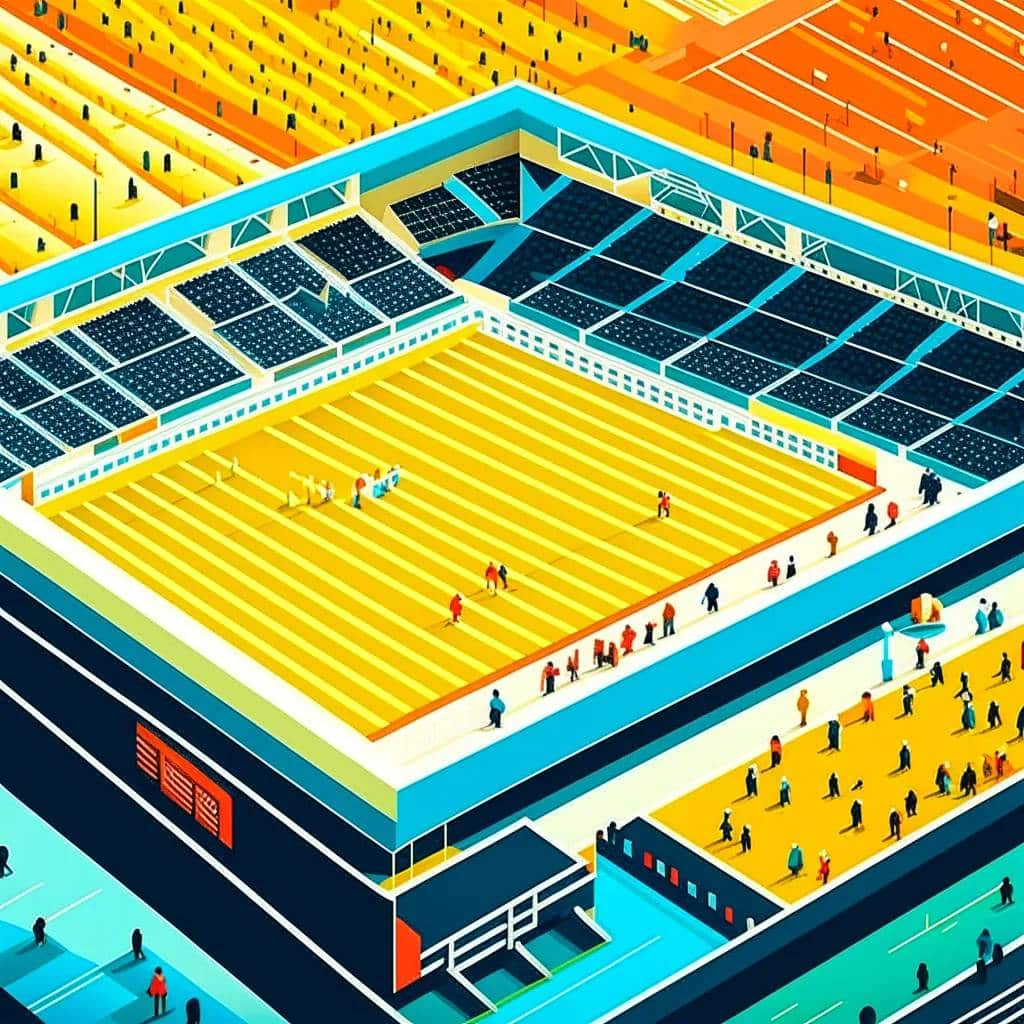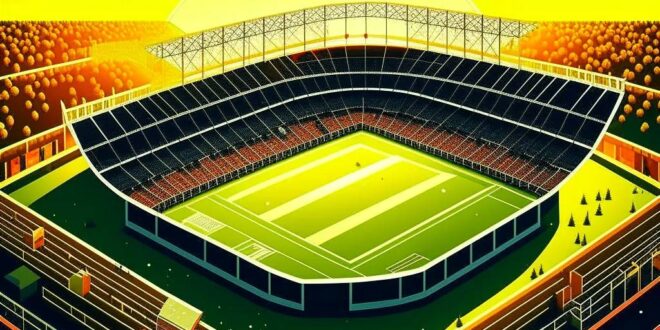Table of Contents
Ever wondered about the history and cultural significance of Salt Lake Stadium Kolkata, India? Built in 1984, Salt Lake Stadium (also known as Vivekananda Yuba Bharati Krirangan) is an iconic football stadium located in Kolkata, India, with seating for 85,000 people. It is the largest football stadium in India—testament to Kolkata’s rich football tradition. In this blog, we’ll take a look at its design, key events, renovations, and how it has become a cultural landmark, youth facility, and driver for reinvigorating world-class football and a source of pride for Kolkata residents. Learn how Salt Lake Stadium has grown into a symbol of culture and a tool for youth development, and why it’s so much more than just a place to play sports.
Key Takeaways
- What makes Salt Lake Stadium in Kolkata, India the best in the world?
- See what major events and tournaments have been hosted in the stadium, and how it has helped shine a spotlight on Indian football around the globe!
- See how renovations, tech, and the stadium as a cultural hub all give back to the community and the economy.
History and Significance of Salt Lake Stadium
Salt Lake Stadium, also known as Vivekananda Yuba Bharati Krirangan, is a historic football stadium in Kolkata, India. Built in 1984 to meet the needs of Kolkata’s fervent football fans.
Establishing a Premier Football Venue
The Salt Lake Stadium was a game-changer for Indian football—the club grounds of the Maidan area in Kolkata were much too small for the increasingly sizable population of football-mad supporters. A stadium built just for football was the clearest signal yet not just of the game’s popularity, but that the city was determined to push Indian football onto the international stage.
Largest Football Stadium in India
The Salt Lake Stadium, which can currently accommodate 85,000 spectators, is the largest football stadium in India. Its size and facilities have made it a preferred venue for large-scale football events, and the home ground for some of Kolkata’s top clubs, including Mohun Bagan, East Bengal, and ATK Mohun Bagan—so in short, it’s kind of a big deal in Indian football.
Elevating Indian Football Globally
Over the years, Salt Lake Stadium has been instrumental in putting Indian football on the world map. It’s been the venue for a number of national and international football matches that have succeeded in making the game a talking point all over the country. From serving as a venue for the FIFA U-17 World Cup to hosting high-profile national team matches, the stadium has given India an outstanding venue to showcase our footballing prowess on an international level.
Impact on Kolkata’s Football Culture
Salt Lake Stadium is one reason Kolkata has such a lively football scene. It’s where many of the city’s most passionate football fans gather to cheer on their favorite clubs—or simply experience the excitement of a live match. But it’s more than just a place for sports. It’s a symbol of Kolkata’s devotion to the game.
Architectural Marvel and Features
The city ground is an architectural wonder that covers a massive 76.40 acres, and is uniquely designed in a bowl shape to ensure spectators have the best possible view from wherever they’re sitting. Every seat has an unobstructed view of the game. This clever planning results in fluid, immersive environments that captivate sports fans and visitors to the area alike.
Stadium Capacity
Originally built to accommodate an impressive 120,000 people, they’ve scaled back to 85,000 to give you more leg room and not feel like a sardine. This means you can expect the same electric atmosphere…but from a much safer distance. In doing so, the venue has gifted all of their fans the highest quality viewing to watch their games, and they’ve clearly designed their stadium around the needs and expectations of the modern sports fan.
Playing Surface
The city ground pitch has come a long way – a lot of work has gone into making sure it measures up to international standards! In 2015, they ripped out the artificial turf and replaced it with a lush natural grass surface. This means athletes can play in the best possible conditions – and it looks great, too.
When you see how much effort they put into their playing surface, you realize that the city ground is just as committed to delivering a world-class sports experience for athletes and spectators, and that they really do value their players and fans.
The city ground itself is a marvel of modern technology, boasting all the bells and whistles like electronic scoreboards and blindingly bright lights. These state-of-the-art toys aren’t just for show – they help create the seamless and immersive environment the city ground is famous for providing.

Major Events and Tournaments
A Historic Moment for Indian Football
The final of the FIFA U-17 World Cup took place in the Salt Lake Stadium in Kolkata recently, and India had never really hosted anything like it before. It was a big deal for Indian football, but it was also a chance to show the world what it could do. Kids from everywhere came to play, and to win, which was really nice.
The stadium was renovated in the run-up to the tournament to ensure that it met all of the FIFA requirements. That meant new seating, new infrastructure, and a whole new experience. Indian football can now stand proudly on the international stage!
Venue for International Football Matches
Salt Lake Stadium is where a lot of the international games of the Indian national team are played. And it’s not for nothing. It’s more than 85,000 people, so it’s one of the biggest stadiums in the world, and that’s a lot of people, which makes for an incredible atmosphere at games. These days, the stadium has also been a fortress for Indian football. The Indian national team plays teams from all over the world here, and it’s a huge matter of pride for the players, and a huge matter of community for the fans. Because it’s also home to Kolkata teams like Mohun Bagan and East Bengal, so it can get quite full for the local rivalry games, and you’ve got a TON of Indian football fans all in one place.
Regular Host of Domestic Leagues
The stadium is a regular host for India’s premier football leagues, the I-League and the Indian Super League (ISL). These leagues are central to the development and popularity of football in India. With many league matches played here, Salt Lake Stadium sees a variety of club competitions, which are crucial to nurturing local talent and giving them a platform to play at a higher level. The packed crowds attending these matches is a testament to the growing football culture and the stadium’s integral role in it. The stadium’s architecture, known for its great viewing angles and large capacities, provides an unrivaled matchday experience, further solidifying its place in Indian football folklore.
Opening Ceremony of IPL
Salt Lake Stadium isn’t just for soccer: in 2013 it was the venue for the Indian Premier League (IPL) opening ceremony—and if a cricket pitch can be laid out here, then this stadium can handle pretty much anything. The scale was massive—they dressed the stadium to the nines to ring in the start of one of the biggest cricket tournaments in the world and brought in big Bollywood stars, as well as international performers, showing that no matter the occasion, this stadium has the cultural wow-factor and fun factor. It’s pretty cool that the IPL opening ceremony happened here. It just goes to show that there’s room for a whole lot more than soccer at this stadium!
Cultural Significance with Concerts
In addition, it serves as a venue for concerts by international musicians, which fans come from all over India to see. Concerts bring different needs than sporting events, and the stadium has been very flexible and good in that regard also. These concerts are a huge part of Kolkata culture, and I love that the city can enjoy international music and entertainment. The stadium becomes very crowded for these concerts, and with good reason – it’s a hugely important cultural site and event venue.
Renovations and Upgrades
2015 Major Overhaul
The 2015 stadium was a major turning point, it was designed as a “big person” stadium, and then when they renovated it for FIFA, they had to change a lot to make it compliant for the U-17 World Cup. It wasn’t a simple renovation, it was essentially building the stadium over in certain areas to bring it up to international standard.
The biggest piece of that was completely new soccer turf, which makes sense, you can’t host an international event without it. The new turf was safe, durable, and played well (in FIFA’s eyes) so the athletes could play well. They made a few small improvements, but basically, they changed a lot of the old to new and turned it into a world-class facility.
Reduction in Seating Capacity
Another big change during the renovation was cutting seating from 120,000 to 85,000. Now you might be asking yourself, “Why reduce the number of seats?” Don’t you want to have as many seats as possible in order to maximize revenue?
It’s a good question, but reducing the number of seats was a good idea for a couple of reasons.
When we had 120,000 seats, the stadium was already too crowded, and the previous seating layout would have made the stadium a fire hazard during major events because the seats were too close together. With the new layout, we were better able to manage crowds, and it was way easier to find emergency exits if we needed to do that, so it was way safer. But if you have 120,000 seats, wouldn’t the layout be the same? Not quite—with 85,000 seats, you can optimize for a different layout that (1) gives better visibility to everyone, and (2) gives everyone a comfortable seat. In other words, you can’t fit 120,000 seats of any configuration that’d give everyone a good seat, but you can with 85,000 seats. So pretty much everyone can watch football games comfortably and safely.
Installation of Bucket Seats
The bucket seating we also introduced to the space was a huge win. Unlike regular bleachers, bucket seating has individual seat units, which means more personal space and a more finished appearance overall.
Each bucket seat also features additional comfort elements like more lumbar support and clearer indication of the seat edge, so there was not any questioning of personal space. This kept guests comfortable and seated for longer periods, so we were able to host much longer events. This also made cleanup easier and faster, so we were able to turn the space over more quickly.
Enhanced Player Facilities
But don’t think the updates were limited to public spaces—player facilities got a glow-up, too. The locker rooms and training rooms were in serious need of an upgrade to meet the professional needs of professional athletes.
The new locker rooms had more space and more goodies. That meant new and improved hydration stations, state-of-the-art lockers, and new therapy equipment. The training space was decked out with the latest in elite fitness and rehab equipment. Together, they gave the players everything they needed to prepare and recover—so they could play their best on game day.
Technological Advancements
The 2015 reno also gave them a chance to play with lots of new cool tech. They put in a lot of new safety systems to keep everyone safe when they come to these events. That means the high def cameras and whatever I don’t even know how to say, but it’s really safe for players and fans.
And they updated the entire broadcast capabilities of the place. With the internet and everything going digital it was kind of a big deal. We were able to broadcast world soccer games in high definition to the whole world, so we were able to bridge the gap between the stadium and the rest of the world. That meant a better experience for people watching at home, and a broader way for the stadium to reach a global audience through media.
Impact on Local Community and Culture
The Salt Lake Stadium in Kolkata, also known as Vivekananda Yuba Bharati Krirangan, is the cultural center of the city and more than just a place to watch soccer – it’s really more than just a soccer stadium.
Serves as a Cultural Hub
The Salt Lake Stadium is an ideal space for concerts, fairs, and other community celebrations that bring people together to honor and revel in Kolkata’s rich cultural heritage. More than just providing entertainment for residents, community celebrations offer an opportunity to build community and in this the stadium provides a perfect backdrop. The stadium is a spacious, modern environment that is perfect for major cultural celebrations and events.
Boosts Local Economy
The Salt Lake Stadium has been good for the local economy, bringing visitors and business to the area. For big games and events, thousands of football fans and visitors flood into the city, and that means lots of hotel rooms, restaurants, and taxis. All of those visitors mean a lot of extra money going to local businesses, and that means a lot of economic growth for the area.
Enhances Kolkata’s Reputation
Salt Lake Stadium is a big reason why Kolkata is known as the football capital of India. The locals’ passion for the sport, combined with their ability to host large matches and tournaments, make the stadium a must-see for football lovers. This doesn’t just bring more people to the city, it makes the city look good on a national and international level.
Provides a Sense of Pride
Kolkata’s Salt Lake Stadium is a source of immense pride for the city. The architectural wonder, the storied history, the emotional investment the city’s football clubs have in the stadium—everything combines to give Kolkatans a strong feeling of possession over the stadium. This is key because it means Kolkatans take tremendous pride in this stadium, and have a very strong feeling of ownership over this stadium. This is key because it means Kolkatans care about this stadium and want to preserve its cultural significance far into the future.
Supports Youth Development
The Salt Lake Stadium has also benefited the children of Kolkata as they pursue their dreams of one day playing football. The stadium offers a variety of football programs and activities including youth development camps and training practices to help children take the steps they need to pursue their dream of playing football professionally. These programs not only keep kids in shape and healthy, but it also helps them develop life skills and learn how to work with others.
In the end, the Salt Lake Stadium has made a significant impact on the Kolkata community and culture. It has become a central meeting spot, it has helped the local economy, it has boosted the city’s reputation, it has given the people a sense of pride, and it has helped the local community with nurturing the next generation of football talent.
Cultural and Sporting Epicenter: Salt Lake Stadium’s Legacy
Salt Lake Stadium, also known as Vivekananda Yuba Bharati Krirangan, is an iconic structure for the people of Kolkata, India. The stadium has represented the community’s passion for football and unity of spirit since it was constructed in 1984. That year, NEC-ITFC was given the task of building a stadium that would boost Indian football to a higher level. Since that time, the unique stadium has been a venue for everything from international matches to music concerts. Not only has it given India a place on the footballing map, it has enriched the culture of Kolkata. When the stadium was redeveloped in 2015, the public saw a transformation. New visitor services, comfortable seating, modern facilities and enhanced security measures were added to make it a more pleasant and comfortable experience for all. The stadium is not just a place to watch football—understandably a source of pride for the people of Kolkata—it’s a cultural institution that delivers economic benefits to the surrounding community, reinforces Kolkata’s reputation as a footballing hub and supports the next generation of young footballers.
Frequently Asked Questions
Q1: What is the significance of Salt Lake Stadium in Indian football?
Salt Lake Stadium, built in 1984 because Kolkata had so many football fans who wanted not only to see Indian football competitive on the world stage, it is now a popular stadium for national and international football matches.
Q2: What makes Salt Lake Stadium the largest football stadium in India?
With 85,000 seats, Salt Lake Stadium is currently the largest football stadium in India. It is the home ground of football clubs Mohun Bagan, East Bengal, and ATK Mohun Bagan and hosts the majority of first tier football matches in the country.
Q3: How has Salt Lake Stadium impacted Kolkata’s football culture?
Salt Lake Stadium is where all the diehard soccer fans of Kolkata flock to to cheer on their respective teams. This is where the local derby and high stakes matches are held, and this is where the city’s love for the sport deepens.
Q4: What architectural features enhance the viewing experience at Salt Lake Stadium?
The stadium is 76.40 acres in size, and bowl-shaped, ensuring there’s not a bad seat in the house. It’s a really immersive experience for spectators, which is amazing for any events you might want to host there.
Q5: Why was the seating capacity of the stadium reduced?
The stadium used to hold 120,000 people, but was reduced to 85,000 for safety and comfort, making crowd management and emergency evacuation routes easier, so everyone can have fun safely.
Q6: What changes were made to the playing surface during renovations?
In 2015 we replaced the artificial turf with natural turf of the highest quality. Just part of a “renovation” to an international caliber pitch that would enhance play, and appearance.
Q7: What role did the stadium play in the FIFA U-17 World Cup?
Salt Lake Stadium hosted the final of the FIFA U-17 World Cup in 2017. This was a really big deal for Indian football because it demonstrated that India can host international sports events and it showed that the game is getting more popular here.
Q8: What are some noteworthy non-football events held at Salt Lake Stadium?
The stadium has been the venue for more than just football though, they’ve also hosted the opening ceremony of the Indian Premier League (IPL) in 2013, and concerts by international artists. It’s events like that that really show how versatile the stadium is, and the cultural significance it has in Kolkata.
Q9: What were the key upgrades made during the 2015 renovation?
In 2015, we upgraded the football field, lowered our seating capacity for safety, and increased the comfort of the seating with bucket seats. We modernized player facilities and added technology, like HD security and HD broadcast.
Q10: How has the stadium contributed to the local economy?
Events at Salt Lake Stadium attract a lot of people, which can mean increased business for nearby hospitality, retail, and transportation venues. More visitors spending money in the area means more local economic development.
Q11: How does the stadium support youth development in football?
Salt Lake Stadium offers a range of youth development programs and training camps to support young children who are interested in pursuing a career in football to grow their skills and chase after their dreams of being a professional player, all while keeping active and learning important life skills.
Q12: Why is Salt Lake Stadium a source of pride for Kolkata residents?
The architectural marvel, rich history, and emotional connection to local football clubs make Salt Lake Stadium feel very much “ours” to many Kolkata residents, in ways that foster community and appreciation for our cultural heritage.



